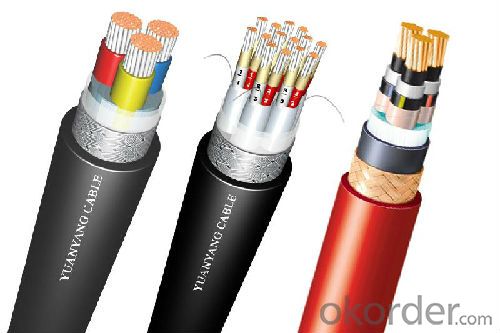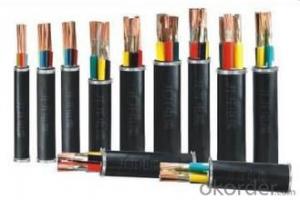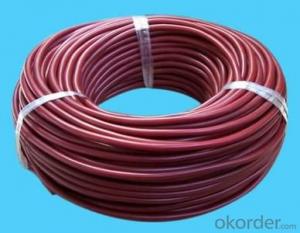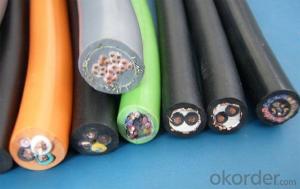Low Voltage(0.6~1kV) PVC insulated electrical power cable
- Loading Port:
- China main port
- Payment Terms:
- TT or LC
- Min Order Qty:
- 100 m
- Supply Capability:
- 20000 m/month
OKorder Service Pledge
OKorder Financial Service
You Might Also Like
Low Voltage(0.6~1kV) PVC Insulated Electrical Power Cable
1. Type, Designation and Application
Type | Designation | Application | |
Cu | Al | ||
VV | VLV | PVC insulated PVC sheathed power cable | Suitable for indoor, channel, conduit. Unable to bear mechanical stress. |
VY | VLY | PVC insulated PE sheathed power cable | |
VV22 | VLV22 | PVC insulated steel-tape armored PVC sheathed power cable | Installed in underground, can bear mechanical stress, but cannot endure large pulling force. |
VV23 | VLV23 | PVC insulated steel-tape armored PE sheathed power cable | |
VV32 | VLV32 | PVC insulated thin steel-wire armored PVC sheathed power cable | Can be installed in vertical well, and bear large mechanical pulling force. |
VV42 | VLV42 | PVC insulated steel-wire armored PVC sheathed power cable | |
VV33 | VLV33 | PVC insulated thin steel-wire armored PE sheathed power cable | |
VV43 | VLV43 | PVC insulated steel-wire armored PE sheathed power cable | |
Note: According to customers’ requirements we can produce flame retardant, fire proof, termite resistant, LSOH and low smoke low halogen, etc.
2. Range of Production
Type | No. of cores | Rated Voltage 0.6/1kV | |
Cu | Al | Nominal cross-section (mm2) | |
VV VY | VLV VLY | 1 | 1.5~630 |
VV22 VV23 | VLV22 VLV23 | 10~630 | |
VV VY | VLV VLY | 2 | 1.5~240 |
VV22 VV23 | VLV22 VLV23 | 4~240 | |
VV32(42) VV33(43) | VLV32(42) VLV33(43) | 4~240 | |
VV VY | VLV VLY | 3 | 1.5~300 |
VV22 VV23 | VLV22 VLV23 | 2.5~300 | |
VV32(42) VV33(43) | VLV32(42) VLV33(43) | 4~300 | |
VV VY | VLV VLY | 4 3+1 | 1.5~300 |
VV22 VV23 | VLV22 VLV23 | 2.5~300 | |
VV32(42) VV33(43) | VLV32(42) VLV33(43) | 4~300 | |
VV VY | VLV VLY | 5 4+1 3+2 | 1.5~300 |
VV22 VV23 | VLV22 VLV23 | 2.5~300 | |
VV32(42) VV33(43) | VLV32(42) VLV33(43) | 4~300 | |
FAQ
Q: How’s your service?
A:1. Offer customers 24/7 service, whenever you need us, we are always here for you.
2. Immediate response. Your any inquiry will be replied within 24 hours.
3. Support small order quantity, for the first time cooperation customers, we can send you less quantity for trial order.
4. Support third party inspection company to inspect and check the quality and quantity before delivery.
Picture

- Q: What is the phase voltage of the three alternating current lines?
- The control cable is divided into two types: power type and signal type. The operating voltage is also divided into high pressure type (within 1000 volts) and low pressure type (within 200 volts) High pressure type for wire power transmission instruction Low pressure type for low-voltage electronic equipment command signal transmission! Including within 127 volts of control power transmission! Practical work commonly known as control cable and signal cable!
- Q: I have two side-by-side outlets. One does not work at all. I've checked all the connections and cannot get it to work.I noticed that the adjacent box has a black and white wire connected while the error box only had a red and white wire going to the box. Is this right? When I test the wires going into the box, there is no voltage whatsoever.
- Get a book on Basic Electrical wiring for homes. From your description I suspect that you have a missing wire in the system. The cable with 3 conductors indicates a switched circuit but it should also have a source for the voltage. If you have a switch in the circuit in the room turn it on and test the device for power. Good luck to you.
- Q: I was just wondering is all electrical high voltage lines including low voltage is isolated to prevent electrical shock.
- Some do and some don't ! High voltage power line that runs at 20000 volts to 50000 volts is a bare wire. Lower voltage street line from pole to pole (about 5000 volts) is also bare wire. After step down by the small street transformer then feed to the house 240 volts is insulated wire. All the AC wiring inside the house carries 120 volts and 240 volts is insulated wire. Most electronic circuit board has printed circuit which has hundreds of bare wire.
- Q: I have a 1981 Ford f-100 I recently went to start it up and the wires that attach to my sylenoidgo too hot and fried. I know that the wires on the back of the sylenoid go to the starter, but where does the wire that attaches to the front go?
- go to auto zone web site they have a lot of self help manuals for free.
- Q: Why does not the birds stand on the high voltage line
- Mac simply can not boot if the computer simply can not boot - you have not heard the boot sound, disk operation sound or fan sound - please try the following steps one by one until you solve the problem so far
- Q: i have tail lights and a right hand turn signal,there is juice getting through the wires. but i have no brake lights. it is a 83 olds. where do i look, or how do i solve this?
- Check the globe for a broken filament. They have 2 filaments in the one globe, one for tail lights and one for brakes.
- Q: After taking off the old one, I noticed there are 3 different wires coming into the bracket. One looks like it goes to an outlet, or the breaker. One goes to the switch, and one goes in the direction of the kitchen.There is a single black that was connected to the fan, and that was it. All others were capped off. Now two blacks and a white were pigtailed with each other, while the other two white were pigtailed together. My question is: How do I install the fan?And why are these wires all over?The house was built in the 70s if it helps.
- ok - that sounds slightly unusual actually the owner (are you renting?) has duty to grant authorized and risk-free living? in case you very own, then your community council will examine, and help rectify probably unsafe wiring. positioned in simple terms, the Earth is there just to guard you from being greatly surprised if the casing of the fixture ought to alter into stay. it particularly is why the fairway/Earth oftentimes attaches to the gentle setting up, and to no longer the gentle itself. to respond to your questions: a million. you are able to set up it. it particularly is slightly risky, yet how low is the ceiling? If it particularly is way extreme and not going to be by risk touched, then no real concern. additionally if the casing is plastic, no longer metallic, you would be safer. yet i think the fan veins are metallic(?) 2. you additionally could make an earth via working an earth twine to the setting up from the different Earthed region. usually each and all of the metallic fittings interior the washing room would be Earthed - so radiators / pipes / bathtub / bathe. in case you have get right of entry to to sufficient of the ceiling areas to run that twine, you additionally could make an Earth. How elementary relies upon on the form of the ceilings and the format of the home. individually, i might in simple terms set up without an Earth. in case you install it properly, there is little risk of you desiring the 'lower back-up' of the Earth connection.
- Q: I have an outdoor electrical outlet in the middle of my backyard. I think the prvious owners used to have a hot tub back there. Anyhow, the pvc conduit coming from the outlet goes into the ground about 10 inches and then I can see the electrical wire buried underground coming towards my house. I would like to just remove the outlet all together without digging it all up because it goes under my porch concrete. Can I just cap it off somehow and bury it? How? Thanks.
- Buy a PVC stopend for about a couple of pennies, You're done.
- Q: What is the difference between RVS and RYS wires?
- KVV Control Cable: Hard Conductor, Class 1 and Category 2 Conductor Voltage 450 / 750vRVV Flexible Cable: Soft Conductor, Category 5 and Category 6 Conductor Voltage 300 / 500V
- Q: I did something very dumb, took a notebook adapter, 19.5 volts 4.62 amps, and atached the two wires to both sides of my head i held it there for sometime and all of a sudden one end got real hot,and I felt the most emotionally depressing , painful feeling in that area. like a frying sensation.I am worried because my head, that exact spot has been hurting on and off for a couple days now, and i have sometime mild pain in and above the eye, which is a symptom of aneurysm.does anyone in here, with knowledge of physics, know what would passing a current like that do to brain tissue?should I be worried, go to ER or just wait a few more days.?
- You must go straight away to the ER, unless you think you're going to become Electro
Send your message to us
Low Voltage(0.6~1kV) PVC insulated electrical power cable
- Loading Port:
- China main port
- Payment Terms:
- TT or LC
- Min Order Qty:
- 100 m
- Supply Capability:
- 20000 m/month
OKorder Service Pledge
OKorder Financial Service
Similar products
Hot products
Hot Searches
Related keywords




























